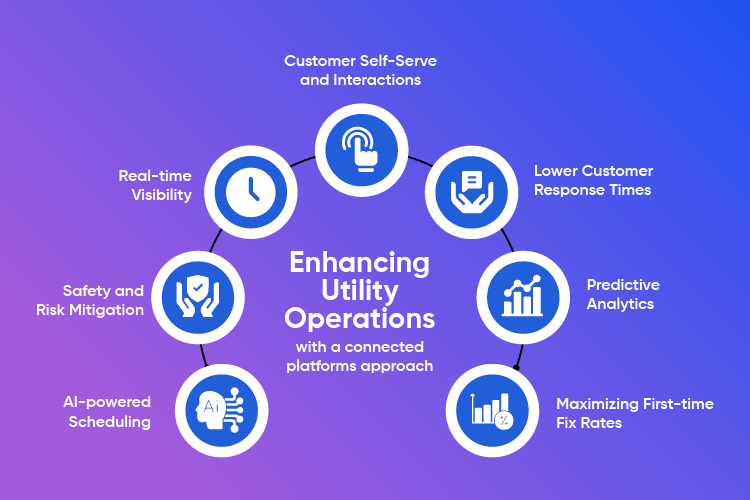- The secret behind successful utility operations
- The next big thing: transforming utility operations with AI and analytics
- Data liberation: unlocking utility success in a Connected Ecosystem
- Enhancing utility operations with vertically integrated and AI-powered connected platforms
- The journey to net zero: embracing sustainability and efficiency
Master Blog
Unlocking Utility Excellence:
The Journey with Connected Platforms

Steve Jobs once famously said, "Technology is nothing. What's important is that you have faith in people, that they're basically good and smart, and if you give them tools, they'll do wonderful things with them." Even in 2024, these words remain highly relevant.
Do you ever wonder - what powers the beating heart of a successful utility operation?
Well, it’s none other than our dedicated field service technicians, the unsung heroes who keep the wheels turning and the lights on. However, let us be realistic, the old-school ways of enabling these field teams with manual processes and disparate systems are no longer effective.
Through my interaction with the utilities and major energy consumers over the years, I’ve gained first-hand insight into behind-the-scenes efforts that drive a successful utility operation. From field service technicians enduring harsh conditions to ensure uninterrupted service, to the intricate dance of managing customer demands and infrastructure upkeep, it's a whirlwind of activity.
Today, the demand to offer value-added services like solar panels and electric vehicle charging is pushing utilities into unfamiliar territory, requiring a diverse skill set to navigate the complexities of emerging business streams. On the flip side, utility customers are also evolving, reshaping the dynamics of the customer-provider relationship. Today's energy consumers wield unprecedented control over their energy usage, armed with an array of tools such as smart thermostats and plugs.
With extreme weather events and the soaring demand for electrification, the pressure's on to adapt, and fast. But fear not, because with challenges come opportunities!
So, what's the next big thing, you ask?
With a laser focus on energy efficiency and sustainability, utilities are donning the hat of trusted advisors, working hand in hand with the field workforce and the customers to achieve common goals. With the aid of advanced analytics, AI-powered platforms, and sophisticated CRMs, utilities are effectively navigating the complex web of expectations, employing predictive analytics to forecast grid demand and real-time usage analytics to match supply with demand.
Instead of the old, siloed approach, utilities today are embracing platforms with a unified mode of operation, using data, automation, and AI to build connected experiences across customers, assets, field workers, and back-office teams. Picture it like a friendly digital assistant who ensures everything runs smoothly while meeting everyone's needs.
I like to call it the connected platform-driven approach in field service management (FSM). In this collaborative ecosystem, it’s not just about supplying energy anymore; it’s about orchestrating a harmonious balance between supply, demand, and the clean energy sector. And let me tell you, it’s a game-changer!
But let's talk turkey – or rather, data liberation to ensure a connected experience…
I believe data liberation is the key to unlocking utility success in a connected ecosystem. By utilizing industry-focused AI algorithms and freeing data from its CRM and asset management shackles, a connected FSM platform unleashes its full potential. This flow of data into the original systems ensures seamless integration of accurate information across the utility value chain. It’s like connecting the dots across customers, field workers, and asset infrastructure to create a seamless experience for everyone.
I believe data liberation is the key to unlocking utility success in a connected ecosystem. By utilizing industry-focused AI algorithms and freeing data from its CRM and asset management shackles, a connected FSM platform unleashes its full potential.
But here's the twist: modern AI-powered platforms can work their magic even with incomplete data. By learning from past experiences and drawing insights from historical data, utility-focused AI/ML algorithms in these connected platforms conjure up relevant schedules and accurate forecasts. This helps the utility to plan both the planned and unplanned work appointments accurately, increase first-time fix rates, estimate power usage, and project accurate billing, despite insufficient data.
And that's just the beginning. With a connected platform approach, utilities today are streamlining everything from scheduling and dispatching to customer service interactions. AI supports frontline field workers in understanding customer needs and preferences, facilitating proactive service delivery while ensuring workforce satisfaction.
Imagine empowering dispatchers to make appointments on the fly or giving customers the convenience of scheduling appointments through a self-serve platform. It’s like bringing the power of a utility right to their fingertips.
Now, let's dive into the nitty-gritty of enhancing utility operations with a connected approach…
From my experience working with global utilities, I understand the challenges of managing day-to-day operations. Whether its planned tasks like meter checks or unexpected issues such as power outages and asset failures, ensuring efficient field operations requires a worker-first mindset. To tackle all these tasks effectively without breaking the bank, I advocate that utilities maintain their competitive edge by embracing vertically integrated platforms that embody field workers’ needs, thus, empowering them to deliver their best performance.
I see several areas where a connected approach with vertically integrated platforms can lead to utility transformation, including:
- AI-Powered Scheduling: Simplifying scheduling using utility-focused AI generates accurate schedules and empowers dispatchers to make appointments on the fly, even with insufficient data.
- Safety and Risk Mitigation: Mobilizing field teams and technicians with apps and access to back-office information enhances safety and productivity.
- Real-time Visibility: Pairing route optimization with AI-powered scheduling and dispatching for ensures efficiency and a seamless workforce-led customer experience.
- Customer Self-Serve and Interactions: Allowing customers the convenience to schedule appointments through an integrated self-serve platform empowers utilities to seize opportunities during customer service interactions to promote relevant products, programs, and services.
- Lower Customer Response Times: Enabling customers to receive updates on the field crew’s location and appointment status, and to engage with the assigned field worker in real-time, results in reduced customer response times.
- Predictive Analytics: Harnessing trapped data across multiple business systems to provide actionable insights to field technicians and managers proactively anticipate future problems or requirements.
- Maximizing First-time Fix rates: Ensuring that when a field technician arrives at the site, they have the correct information, skills, and tools to address the issue promptly, which improves first-time fix rates.
The utility transformation led by the connected platforms approach does not stop here. As utilities march towards net zero emissions, connected platforms are leading the charge.

The Journey to Net Zero…
As a utility, you have got infrastructure spread far and wide. Now, keeping tabs on all of it can be a real headache. Today, with remote monitoring and predictive maintenance solutions, we can spot potential issues before they spiral out of control. It is like having a crystal ball that tells us exactly where to focus our attention, saving us time, money, and a whole lot of hassle.
This proactive approach isn't just good for the bottom line, it’s also great for the environment. By addressing issues early on, we are reducing the need for reactive maintenance activities that often involve tons of travel and emissions. It’s a win-win situation - we are improving the reliability and resilience of our infrastructure while doing our part to protect the planet.
By coordinating renewable energy integration and predictive maintenance efforts, connected platforms are emerging as crucial allies, serving as more than just facilitators but as pivotal drivers toward sustainability. These platforms are increasingly playing a central role in not only steering utilities towards a greener future but also in maximizing operational efficiency
In summary, within the context of utilities and field service operations, embracing a technology-driven and interconnected approach serves as a game-changer for unlocking utility excellence, paving the way toward sustainability and operational efficiency.
Footnote
SEW’s innovative and connected digital platforms are proven enablers that are empowering utilities worldwide for charting the course of digital transformation across the value chain – from customers, field workers, assets, and back office. To learn more, reach us at [email protected]






